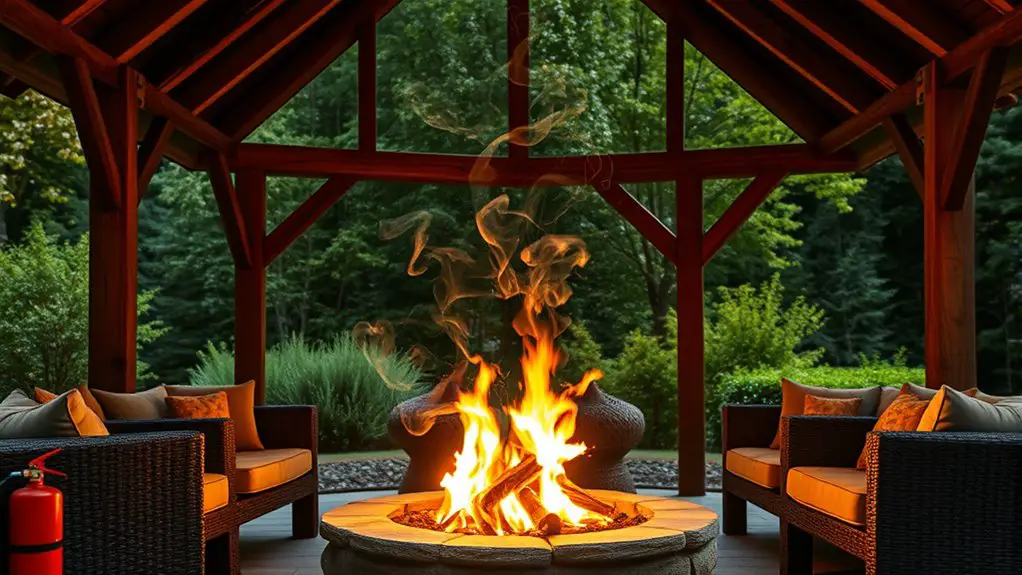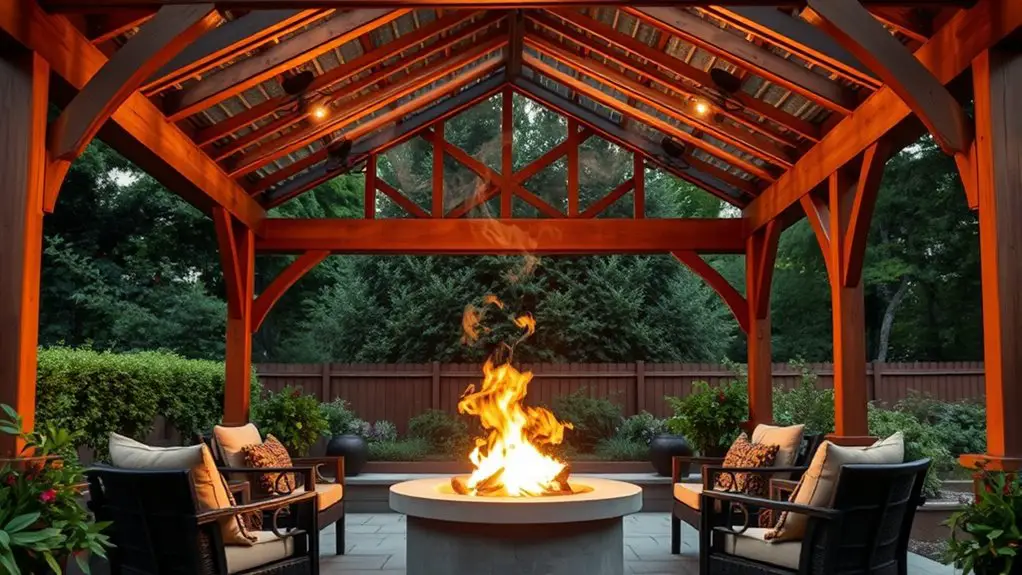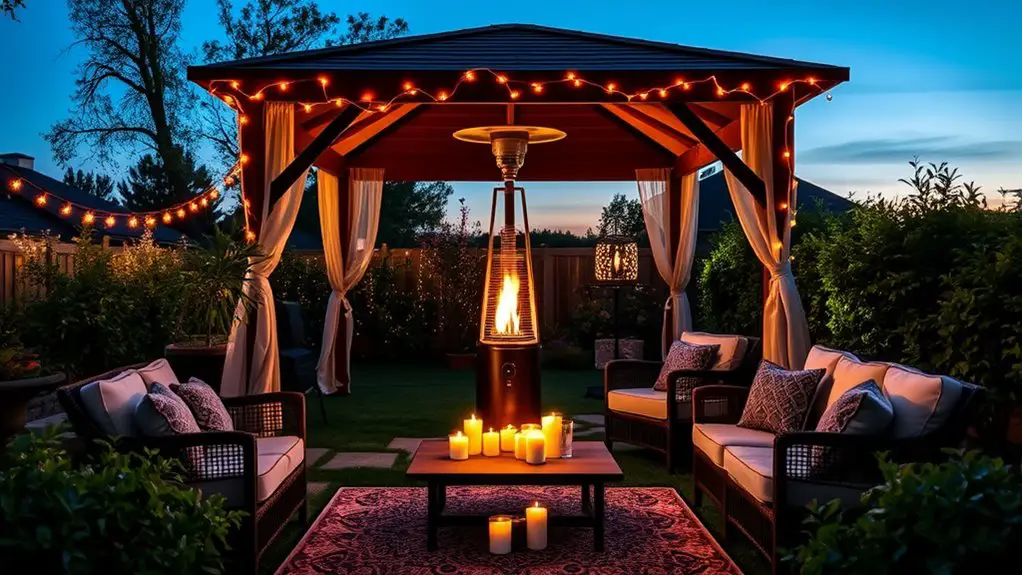Using a fire pit under a gazebo can be risky. The enclosed space may trap heat and smoke, increasing fire hazards and the risk of ignition for flammable materials. Proper ventilation is essential to prevent these dangers, and you should always maintain a safe distance from combustibles. It’s also vital to comply with local regulations and have safety measures in place. There are safer alternatives you might want to contemplate for outdoor warmth and ambiance.
Understanding the Risks of Fire Pits Under a Gazebo

While enjoying a cozy evening by your fire pit under a gazebo might seem inviting, it’s essential to understand the potential risks involved. Fire pits generate considerable heat, which can lead to dangerous heat buildup in enclosed spaces. This creates fire hazards, especially if your gazebo is constructed from flammable materials like wood or fabric.
The confined area can trap heat and smoke, increasing the risk of ignition. Additionally, embers can escape from the fire pit, igniting nearby structures or decorations. It’s imperative to maintain a safe distance between the fire pit and any combustible materials.
Before lighting a fire, consider the ventilation and the material of your gazebo. Ensuring you have adequate clearance reduces fire hazards considerably. Ultimately, while the allure of a fire pit may be tempting, prioritizing safety is essential to fully enjoy your evenings without worry. Always check for local regulations regarding fire pits in enclosed structures to ensure compliance and safety.
Importance of Proper Ventilation
Proper ventilation is essential when using a fire pit under a gazebo, as it helps to prevent the buildup of heat and smoke, which can pose serious health and safety risks. Effective ventilation design and airflow management are vital for a safe and enjoyable experience.
Here’s a table illustrating the importance of ventilation:
| Factor | Impact | Solution |
|---|---|---|
| Heat Buildup | Can lead to fire hazards | Guarantee open sides |
| Smoke Accumulation | Affects air quality | Use exhaust fans |
| Carbon Monoxide | Dangerous gas can accumulate | Install CO detectors |
| Comfort Level | Reduces enjoyment of space | Design for cross-ventilation |
Choosing the Right Fire Pit for Your Gazebo

When selecting a fire pit for your gazebo, it’s essential to take into account both safety and functionality to guarantee a pleasant experience. Start by considering the fire pit materials. Steel and cast iron are durable options but can retain heat, so make sure they’re placed safely away from flammable surfaces. If your gazebo design includes a wooden structure, opt for a heat-resistant fire pit to prevent damage.
Next, think about the size and style of the fire pit. It should complement your gazebo’s design while providing enough heat for your space. Portable fire pits offer flexibility, allowing you to reposition them as needed. Additionally, make certain your fire pit has a proper base to prevent tipping and to protect the ground underneath. By choosing wisely, you can enjoy the warmth and ambiance of a fire pit in your gazebo without compromising safety or style. Always ensure proper ventilation to reduce smoke and gas buildup when using a fire pit in an enclosed space.
Safety Precautions to Consider
Before you light up your fire pit under the gazebo, it’s crucial to contemplate several safety precautions to guarantee a worry-free experience. First, check your gazebo materials; flammable structures made of wood or fabric could pose serious fire risks. Opt for non-combustible materials, which provide a safer environment for your fire pit. Verify your fire pit is at least 10 feet away from any walls, furniture, or other hazards.
Always have a fire extinguisher or a bucket of water nearby for quick access in case of emergencies. Keep the area well-ventilated to prevent smoke buildup, which can be harmful. Pay attention to local regulations regarding fire safety, as they may dictate when and how you can use your fire pit. Additionally, be aware that using a fire pit under a gazebo can increase the risk of lightning strikes, especially during storms, making it essential to monitor weather conditions. Finally, never leave your fire unattended, and always fully extinguish it when you’re done. Your safety and that of others should always come first.
Alternatives to Using a Fire Pit Under a Gazebo

While enjoying the outdoors under your gazebo, you might consider alternatives to a traditional fire pit that provide warmth and ambiance without the associated risks. One option is an electric or propane patio heater, which can efficiently warm your space without the dangers of open flames. Another choice is a tabletop fire bowl, designed specifically for safety and portability, ideal for a wooden deck or outdoor patio.
Additionally, you could use lanterns or string lights for a cozy atmosphere without the risk of heat and smoke. If you’re looking for a more natural feel, consider a chiminea or fire column, which directs heat upward while minimizing fire hazards. It’s important to note that electric heaters offer energy-efficient options that can effectively heat smaller areas, making them a great choice for gazebo settings.
Frequently Asked Questions
Can I Use a Propane Fire Pit Under a Gazebo?
Using a propane fire pit under your gazebo can pose risks. Always follow fire pit safety practices and propane guidelines. Guarantee proper ventilation, keep flammable materials away, and check local regulations to enjoy safely.
What Materials Are Safest for a Gazebo Near a Fire Pit?
When building your gazebo, remember the tale of Prometheus. Use fire resistant materials like metal or treated wood, and apply heat resistant finishes. This’ll help guarantee safety while you enjoy your outdoor space freely.
How Far Should a Fire Pit Be From My Gazebo?
For safe fire pit placement, guarantee your fire pit’s at least 10-15 feet from your gazebo. Following safety guidelines helps prevent accidental fires, allowing you to enjoy your outdoor space freely and safely.
Are There Any Local Regulations for Fire Pits Under Gazebos?
You should check your local regulations regarding fire pits, as they vary considerably. Some areas may have restrictions on placement or usage, especially under structures like gazebos, to guarantee safety and compliance with fire codes.
What Are the Signs of Unsafe Fire Pit Usage Under a Gazebo?
When flames dance too close, you might notice soot on the walls or a warped ceiling—clear signs of heat damage. Prioritize fire safety; if smoke fills the space or you feel intense heat, it’s time to rethink.

